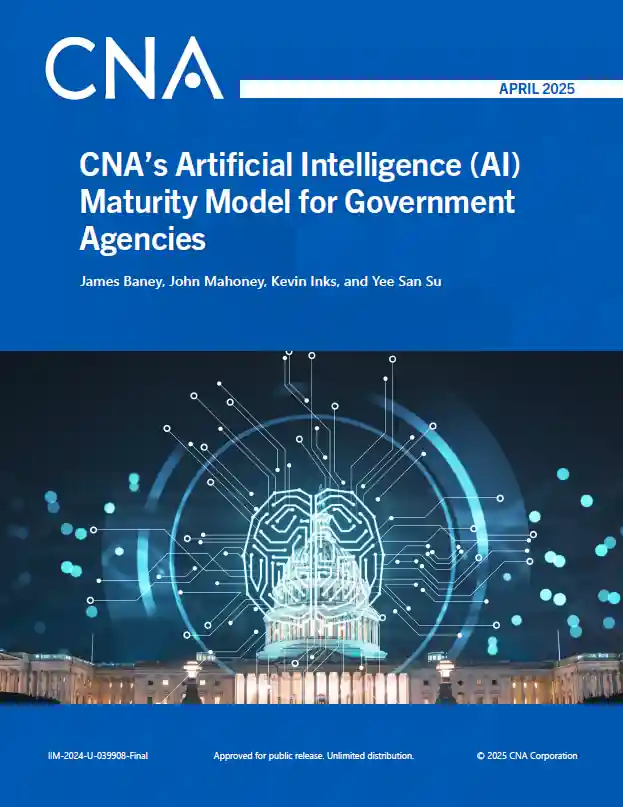The CNA AI Maturity Model enables government agencies to understand and communicate the current maturity level of their AI programs, the level of maturity they are striving to achieve in a given period of time, and the path to get there. The model is robust, based on key government guidance documents and industry literature. It is designed for federal, state, or local programs.

| Subdomain | Topic | Current Maturity | Goal Maturity |
|---|---|---|---|
| Datasets | Data quality | Performed | Established |
| Data accessibility | Performed / Established | Established | |
| Infrastructure | Computing infrastructure | Performed | Established |
| Data storage infrastructure | Performed | Established | |
| Testing infrastructure | Developing | Performed | |
| Infrastructure accessibility | Performed | Established | |
| Procurement | Procurement processes | Performed | Established |
| Workforce and Expertise | Skills and workforce planning | Performed | Established |
| Recruitment and retention | Established | Optimized | |
| Fostering of emerging talent | Established | Established | |
| Enhancement of AI literacy | Performed | Established / Optimized |
Benefits of using the CNA AI Maturity Model for Government Agencies
- Understand your program's AI maturity-where you are now and where you're going.
- Get a graphical output that quickly and easily communicates your maturity to internal and external stakeholders-illustrate the formality and thought behind your program.
- Know that your output is based upon a comprehensive, robust model developed by CNA's AI and strategy experts. It is defensible and justifiable for any audience.
- Leverage the 450 milestones built into the maturity model to create your AI program development roadmap.
- Implementation scales with your program: start small and increase stakeholder input over time.

| Domain | Subdomain |
|---|---|
| Productive governance models are established |
|
| Efforts are sufficiently resourced |
|
| Outputs are impactful |
|
| Products and results are trustworthy |
|
| Products are safe and secure |
|
Contact CNA to discuss support using the CNA AI Maturity Model. We can assist you with collecting stakeholder input, identifying which milestones you have achieved and which you intend to work toward, translating your inputs into a graphical output, developing a roadmap to achieve your next level of maturity, understanding your results, and/or customizing the maturity model for unique use cases. Email us at AIMaturity@cna.org. Your message will go directly to the project team.
Request a speaker. Are you hosting an event about AI and want to include a discussion about the value of measuring AI maturity and how to get started? Email us at AIMaturity@cna.org. We can likely provide you with a speaker, often at no cost.
Frequently Asked Questions
What is the CNA Artificial Intelligence Maturity Model for Government Agencies?
The CNA Artificial Intelligence Maturity Model for Government Agencies is a tool that helps government agencies assess and improve their AI capabilities. It defines a framework for the AI-related activities that government agencies perform and provides a benchmark agencies can use to evaluate how they develop, use, and oversee AI as it relates to their missions.
What does it seek to do?
The maturity model seeks to enable government agencies to better plan how to advance their AI capabilities. This includes:
- Helping agencies understand their current AI maturity levels by comparing their activities against a standard
- Allowing agencies to identify specific objectives for future AI maturity
- Identifying specific milestones that agencies can target to incrementally increase maturity levels as they fill capability gaps
What need does this fill?
Government agencies need tools to help them develop actionable plans for AI improvement. Other AI maturity models are either too vague and high-level to be useful in planning efforts or too narrowly focused to apply across the breadth of government agency activities. The CNA AI Maturity Model for Government Agencies provides both the breadth and specificity that agencies need to develop actionable plans. It is:
- Comprehensive of government AI activities-The model covers the full breadth of activities needed to ensure that AI efforts are effectively governed, sufficiently resourced, impactful, trustworthy, and secure.
- Detailed and specific-The model includes specific indicators that clearly illustrate different levels of maturity across each domain of AI operations, allowing agencies to easily assess their maturity and to identify targets for improvement.
- Tailorable-Agencies can use the model to assess the full suite of their AI operations, or they can apply it only to select, high-priority programs or areas of focus.
How do I use it?
Typical use of the maturity model includes:
- Performing a self-assessment of current AI capability levels by comparing the agency's present-day activities to the model's maturity indicators.
- Identifying target capability levels that the agency would like to achieve in the future by identifying the maturity indicators the agency would like to meet within the planning horizon.
- Prioritizing the gaps between current and targeted capability levels and using the model's maturity indicators to develop plans to close high-priority capability gaps.
Details
- Pages:
- Document Number:
- Publication Date: 5/1/2025
